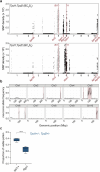Teosinte Pollen Drive guides maize diversification and domestication by RNAi
- PMID: 39112710
- PMCID: PMC11390486
- DOI: 10.1038/s41586-024-07788-0
Teosinte Pollen Drive guides maize diversification and domestication by RNAi
Abstract
Selfish genetic elements contribute to hybrid incompatibility and bias or 'drive' their own transmission1,2. Chromosomal drive typically functions in asymmetric female meiosis, whereas gene drive is normally post-meiotic and typically found in males. Here, using single-molecule and single-pollen genome sequencing, we describe Teosinte Pollen Drive, an instance of gene drive in hybrids between maize (Zea mays ssp. mays) and teosinte mexicana (Z. mays ssp. mexicana) that depends on RNA interference (RNAi). 22-nucleotide small RNAs from a non-coding RNA hairpin in mexicana depend on Dicer-like 2 (Dcl2) and target Teosinte Drive Responder 1 (Tdr1), which encodes a lipase required for pollen viability. Dcl2, Tdr1 and the hairpin are in tight pseudolinkage on chromosome 5, but only when transmitted through the male. Introgression of mexicana into early cultivated maize is thought to have been critical to its geographical dispersal throughout the Americas3, and a tightly linked inversion in mexicana spans a major domestication sweep in modern maize4. A survey of maize traditional varieties and sympatric populations of teosinte mexicana reveals correlated patterns of admixture among unlinked genes required for RNAi on at least four chromosomes that are also subject to gene drive in pollen from synthetic hybrids. Teosinte Pollen Drive probably had a major role in maize domestication and diversification, and offers an explanation for the widespread abundance of 'self' small RNAs in the germ lines of plants and animals.
© 2024. The Author(s).
Conflict of interest statement
The authors declare no competing interests.
Figures
















Update of
-
Teosinte Pollen Drive guides maize diversification and domestication by RNAi.bioRxiv [Preprint]. 2023 Nov 10:2023.07.12.548689. doi: 10.1101/2023.07.12.548689. bioRxiv. 2023. Update in: Nature. 2024 Sep;633(8029):380-388. doi: 10.1038/s41586-024-07788-0. PMID: 37503269 Free PMC article. Updated. Preprint.
References
MeSH terms
Substances
Grants and funding
LinkOut - more resources
Full Text Sources
Molecular Biology Databases

